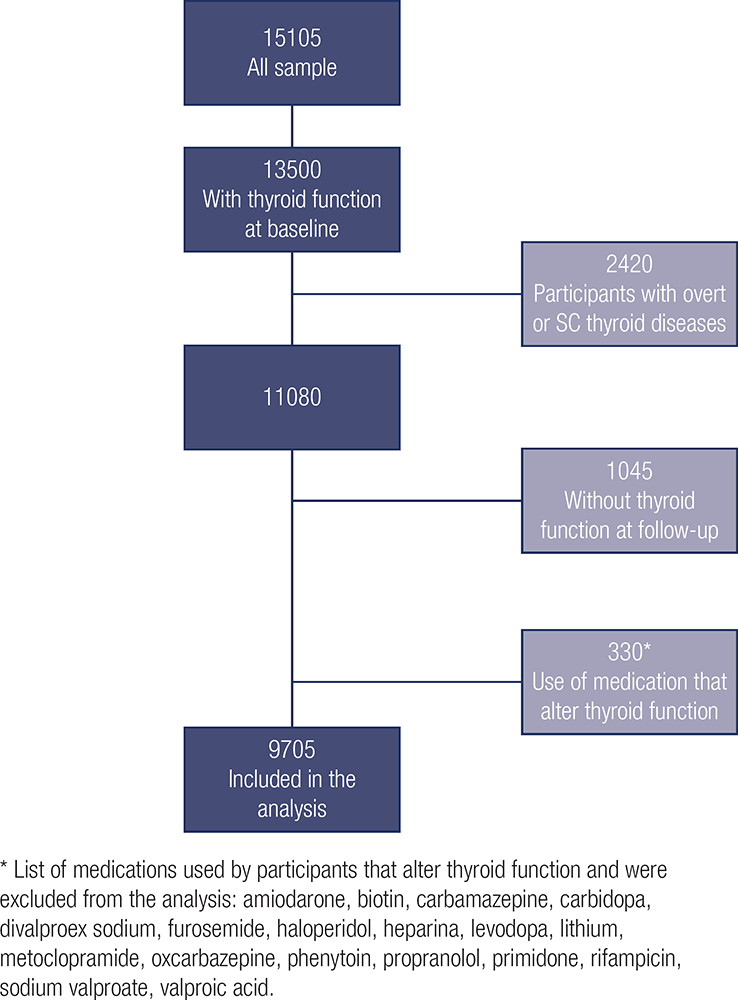Daniela Barros, post graduate student of the Surgical Clinic Program at Ribeirão Preto Medical School, University of São Paulo (FMRP-USP). Ribeirão Preto, SP, Brazil.
The Brazilian Longitudinal Study of Adult Health (ELSA-Brasil) is a prospective cohort study of 15,105 civil servants, examined at baseline (2008-2010) and over a 4-year follow-up (2012-2014). This analysis included 9,705 participants with normal thyroid function at baseline, follow-up information about thyroid function and with no report of using drugs that may interfere in the thyroid function. Thyroid function was defined by TSH/FT4 levels or routine use of thyroid hormones/anti-thyroid medications. Annual and cumulative (over 4-year) incidence rates were presented as percentages (95% CI) (Arch Endocrinol Metab., vol. 65, no.4).
This multicenter trial, named Incidence of thyroid diseases: Results from the Brazilian Longitudinal Study of Adult Health (ELSA-Brasil), was conducted in six teaching and research institutions located in six different cities in Brazil: Salvador (Universidade Federal da Bahia – UFBA, 2029 participants), Vitória (Universidade Federal do Espírito Santo, 1055 participants), Belo Horizonte (Universidade Federal de Minas Gerais, 3115 participants), Rio de Janeiro (Fundação Oswaldo Cruz, 1784 participants), São Paulo (Universidade de São Paulo – USP, 5061 participants), and Porto Alegre (Universidade Federal do Rio Grande do Sul, 2061 participants). The leading researcher is Isabela M. Benseñor, from USP (BENSENOR, I.M., et al).
The results showed a high incidence of hypothyroidism, which is compatible with a country with a more-than-adequate iodine intake. The low women: men ratio of the incidence of thyroid dysfunction highlights the importance of the diagnosis of thyroid diseases among men in Brazil (BENSENOR, I.M., et al).

Image: BENSENOR, I.M., et al. .
Thyroid dysfunction is a very common disease in the general population worldwide (CHAKER, L., et al; DE LEO, S., et al). Although there are a considerable number of prevalence studies, data on the incidence of thyroid diseases are still scarce. Few studies have evaluated the incidence of thyroid diseases worldwide, such as subclinical and overt hyperthyroidism and hypothyroidism (MANDARIGA, A.G., et al; AMINORROAYA, A., et al).
Epidemiological studies on the incidence of thyroid diseases are very important, because many patients are asymptomatic or have reported unspecific symptoms, which can lead to a high rate of underdiagnosis (CHAKER, L., et al; DE LEO, S., et al; AMINORROAYA, A., et al).
In Brazil, some information can be found regarding the prevalence of thyroid diseases in population-based (BENSENOR, I.M., et al [2011]; SICHIERI, R., et al) and large epidemiological studies (OLMOS, R.D., et al). The available data indicate rates within the highest prevalence of hypo-and hyperthyroidism in the world (TAYLOR, P.N., et al). However, to the best of our knowledge, no large study on the incidence of thyroid diseases in Brazil has been conducted to date.
The incidence of all overt and subclinical thyroid disease in the ELSA-Brasil trial was 6.7% (1.73%/year): 0.19% for overt hyperthyroidism (0.048%/year), 0.54% for subclinical hyperthyroidism (0.14%/year), 1.98% for overt hypothyroidism (0.51%/year), and 3.99% for subclinical hypothyroidism (1.03%/year). The incidence of all thyroid diseases was higher in women, when compared to men, with a low women: men ratio (1.36) (BENSENOR, I.M., et al).
The present study showed, for the first time, a high annual and cumulative incidence of new overt and subclinical hyperthyroidism and hypothyroidism in a large Brazilian cohort after a 4-year follow-up. The results highlighted a higher incidence of hypothyroidism in the country, but a similar incidence of hyperthyroidism compared to other countries worldwide. Our data also presented lower women: men ratio for thyroid diseases compared to other classical studies that evaluate thyroid function (BENSENOR, I.M., et al).
This study also has some strengths. Thyroid function at baseline and after a 4-year follow-up were measured, which allowed us to determine the incidence of thyroid diseases in Brazil for the first time in a large and multicentric sample. Although the higher frequency of women, the study included a similar number of men. Study protocols were exactly the same for all centers, and data collection was performed under strict quality control. These results in a highly admixed population bring original information about the incidence of thyroid diseases in participants that self-reported themselves as Mixed, a group that, except for a previous study in Brazil (SICHIERI, R., et al), had never been analyzed in other studies (BENSENOR, I.M., et al).
In conclusion, results from ELSA-Brasil showed that the high incidence of hypothyroidism may well be compatible with a country with a more-than-adequate iodine intake. Incident data also showed low women: men ratio for thyroid diseases and a lower proportion of treatment in men with overt thyroid diseases compared to women. Both data highlight the importance of the diagnosis and treatment of thyroid diseases among men in Brazil (BENSENOR, I.M., et al).
References
AMINORROAYA, A., et al. Incidence of thyroid dysfunction in an Iranian adult population: the predictor role of thyroid antibodies: results form a prospective population-based cohort study. Eur J Med Res. 2017, vol. 22, no 1, pp.21. [viewed 25 October 2021]. https://doi.org/10.1186/s40001-017-0260-2. Available from: https://eurjmedres.biomedcentral.com/articles/10.1186/s40001-017-0260-2
BENSENOR, I.M., et al. Incidence of thyroid diseases: Results from the Brazilian Longitudinal Study of Adult Health (ELSA-Brasil). Arch Endocrinol Metab. 2021, vol. 65, no 4, pp. 468-478 [viewed 25 October 2021]. https://doi.org/10.20945/2359-3997000000348. Available from: https://www.scielo.br/j/aem/a/PZWqJmXSdQpVdmk3kK8hz7D/abstract/?lang=en
BENSENOR, I.M., et al. Prevalence of thyroid disorders among older people: results from the Sao Paulo Ageing & Health Study. Cad Saude Publica. 2011, vol. 27, no 1, pp.155-61 [viewed 25 October 2021]. https://doi.org/10.1590/S0102-311X2011000100016. Available from: https://www.scielo.br/j/csp/a/RdRsk8mZz5YvSPXpJ5Jxq4b/?lang=en
CHAKER, L., et al. Hypothyroidism. Lancet. 2017, vol. 390, no 10101, pp. 1550-62 [viewed 25 October 2021]. https://doi.org/10.1016/S0140-6736(17)30703-1. Available from: https://www.thelancet.com/journals/lancet/article/PIIS0140-6736(17)30703-1/fulltext
DE LEO, S., et al. Hyperthyroidism. Lancet. 2016, vol. 388, no 10047, pp. 906-18 [viewed 25 October 2021]. https://doi.org/10.1016/S0140-6736(16)00278-6. Available from: https://www.thelancet.com/journals/lancet/article/PIIS0140-6736(16)00278-6/fulltext
MADARIAGA, A.G., et al. The incidence and prevalence of thyroid dysfunction in Europe: a meta-analysis. J Clin Endocrinol Meta. 2014, vol. 99, no. 3, pp.923-31. [viewed 25 October 2021]. https://doi.org/10.1210/jc.2013-2409. Available from: https://academic.oup.com/jcem/article/99/3/923/2537300
OLMOS, R.D., et al. Gender, race and socioeconomic influence on diagnosis and treatment of thyroid disorders in the Brazilian Longitudinal Study of Adult Health (ELSA-Brasil). Braz J Med Biol Res. 2015, vol. 48, no 8, pp. 751-8 [viewed 25 October 2021]. https://doi.org/10.1590/1414-431X20154445. Available from: https://www.scielo.br/j/bjmbr/a/Np6WPw6KFpf6GtYF5Pypn4p/?lang=en
SICHIERI, R., et al. Low prevalence of hypothyroidism among black and Mulatto people in a population-based study of Brazilian women. Clin Endocrinol. 2007, vol. 66, no 6, pp. 803-7 [viewed 25 October 2021]. https://doi.org/10.1111/j.1365-2265.2007.02816.x. Available from: https://onlinelibrary.wiley.com/doi/10.1111/j.1365-2265.2007.02816.x
TAYLOR, P.N. et al. Global epidemiology of hyperthyroidism and hypothyroidism. Nat Rev Endocrinol. 2018, vol. 14, no 5, pp. 301-16 [viewed 25 October 2021]. https://doi.org/10.1038/nrendo.2018.18. Available from: https://www.nature.com/articles/nrendo.2018.18
To read the article, acess
BENSENOR, I.M., et al. Incidence of thyroid diseases: Results from the Brazilian Longitudinal Study of Adult Health (ELSA-Brasil). Arch Endocrinol Metab. 2021, vol. 65, no 4, pp. 468-478. [viewed 25 October 2021]. https://doi.org/10.20945/2359-3997000000348. Available from: https://www.scielo.br/j/aem/a/PZWqJmXSdQpVdmk3kK8hz7D/abstract/?lang=en
External links
Archives of Endocrinology and Metabolism – AEM: https://www.scielo.br/aem
Isabela M. Benseñor | ORCID: https://orcid.org/0000-0002-6723-5678
Como citar este post [ISO 690/2010]:



















Recent Comments